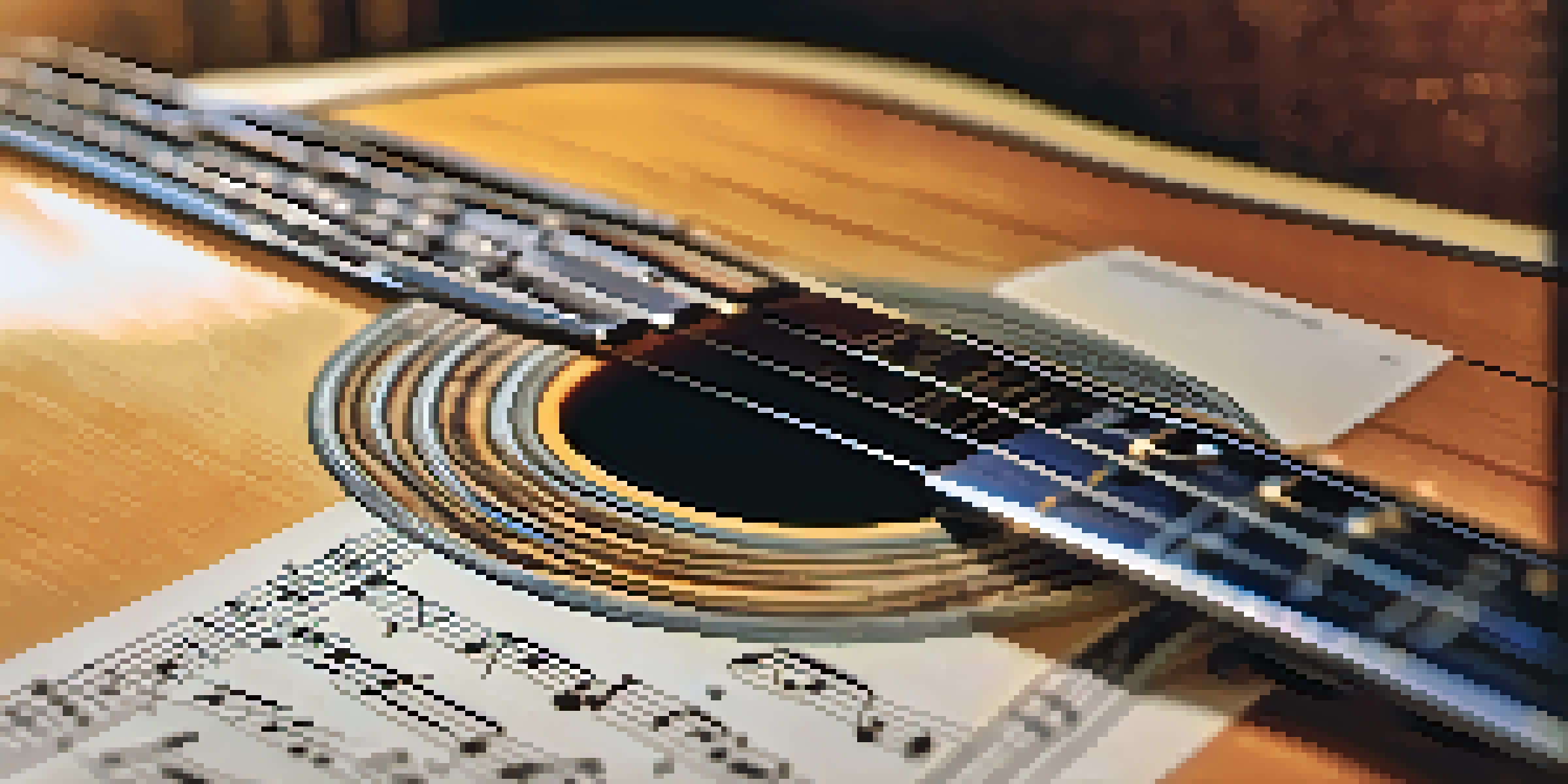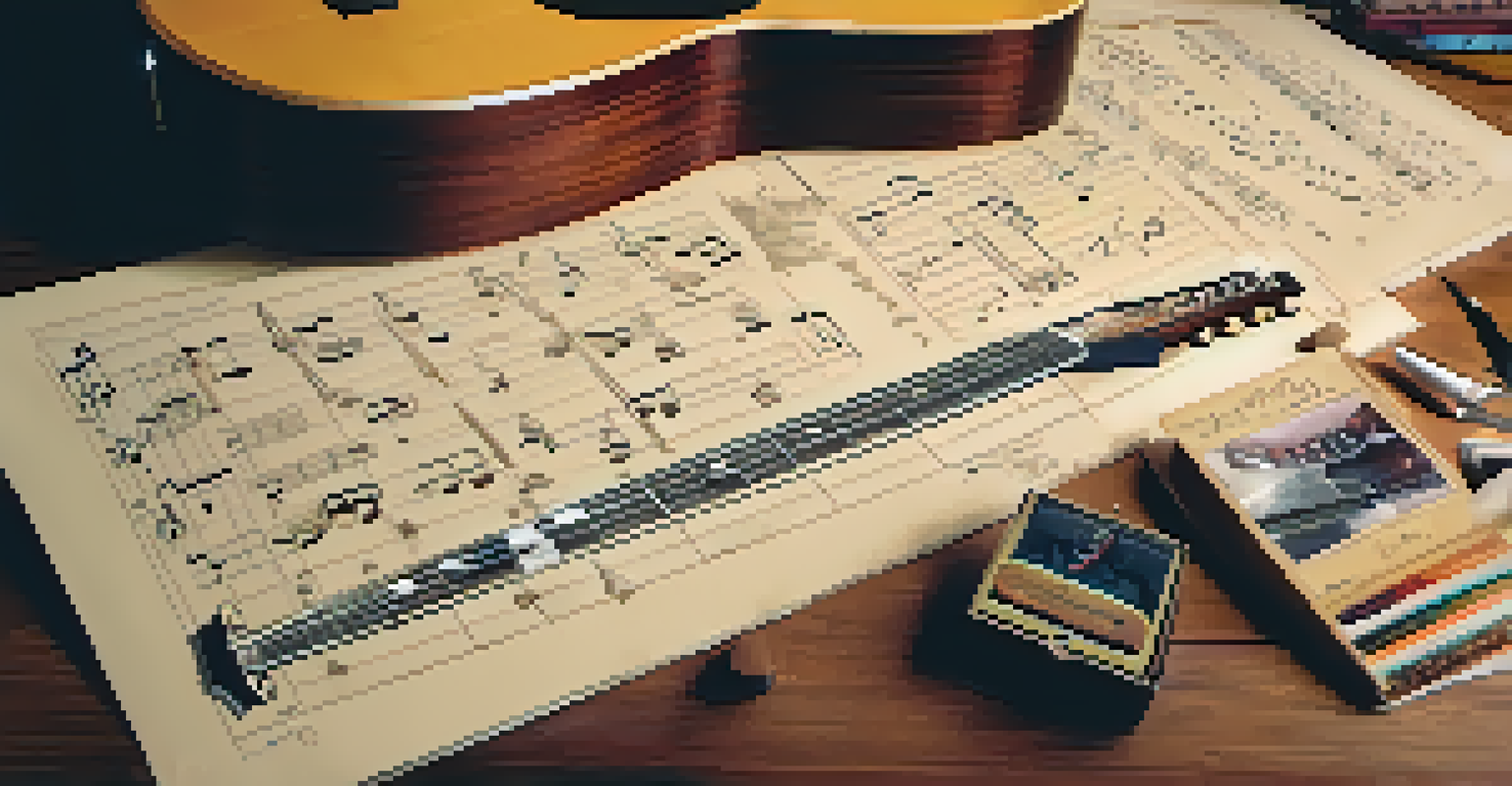The Art of Transposing Songs for Guitar: A Step-by-Step Guide

Understanding Transposition: What It Means for Guitarists
Transposing is the process of changing the key of a song while keeping its melody and harmony intact. For guitarists, this is a valuable skill that allows them to play songs in keys that suit their vocal range or the instruments they're playing with. Essentially, it's like taking a painting and moving it to a different wall without altering the artwork itself.
Transposition is the key to unlocking new possibilities in music.
Imagine trying to sing a beautiful song but finding it too high or too low for your voice. By transposing, you can shift the entire song to a more comfortable key, making it easier for you to perform. This flexibility opens up a world of possibilities, allowing you to adapt songs for different situations, whether you're jamming with friends or performing on stage.
In this guide, we'll break down the steps involved in transposing songs for guitar, making it a straightforward process. With a bit of practice, you'll be able to tackle any song, regardless of its original key, and play it confidently.
Gathering the Tools You Need for Transposition
Before diving into transposing, it's crucial to have a few tools at your disposal. A good guitar tuner, a capo, and a transposition chart or app can make the process smoother. Think of these tools as your toolbox, equipping you to tackle any song with ease.

A capo, for example, is a simple device that clamps down on the guitar strings at a specific fret. This allows you to play in a higher key without changing your finger positioning for chords. It's like having a magical wand that instantly changes the key of your song without much effort.
Transposing Simplifies Performance
Transposing allows guitarists to adjust the key of a song to better suit their vocal range or the instruments they're playing with.
Having a transposition chart handy can also be beneficial. These charts list the original chords in a song alongside their transposed equivalents, making it easy to see which chords to play in your new key. With these tools, you're well on your way to mastering the art of transposing.
Identifying the Original Key of the Song
The first step in transposing a song is to identify its original key. This involves looking at the chords used in the song and determining which key they belong to. If you're unsure, try playing the song along with a recording or consult a chord chart online.
Music is the shorthand of emotion.
For instance, if you see chords like G, C, and D, the original key is likely G major. Once you've pinpointed the key, you'll find it easier to figure out how to shift the song to your desired key. It's similar to knowing the starting point before plotting a new route on a map.
This step is crucial, as it sets the foundation for the entire transposition process. Understanding the original key will help you maintain the song's structure and harmony, ensuring your version sounds just as good as the original.
Choosing Your New Key: Tips and Tricks
Selecting a new key involves considering your vocal range and the overall feel of the song. If you're a tenor singer, for instance, you might want to transpose a song down a half step or a whole step to make it easier to sing. Think of this choice as finding the perfect outfit for a special occasion; it needs to fit well and feel comfortable.
Another tip is to consider the instruments playing alongside you. If you're jamming with a group, you want to choose a key that complements the other instruments, such as the piano or saxophone. This collaboration enhances the overall sound and makes for a more enjoyable experience for everyone involved.
Tools for Easy Transposition
Using a capo and a transposition chart can greatly simplify the process of changing keys while maintaining the song's structure.
Often, guitarists will choose keys like C, G, or D, as they are easier to play and tend to sound great with various songs. Experimenting with different keys can also lead to discovering unique sounds and textures in familiar songs, giving them a fresh twist.
Using a Capo for Easy Transposition
One of the simplest ways to transpose songs is by using a capo. By placing the capo on a specific fret, you can instantly change the key of your guitar without having to learn new chord shapes. It's like having a shortcut that allows you to reach your destination faster.
For example, if a song is in the key of G and you want to play it in A, simply place the capo on the second fret and play the same G chord shapes. This method not only simplifies the transposition process but also keeps the song's original feel intact.
Capos are particularly useful for beginners or those who might struggle with complex barre chords. They allow you to focus on playing the song rather than getting bogged down by challenging finger placements. With a capo, you can play along with your favorite songs in a flash!
Transposing Chords: Step-by-Step Process
Now that you've identified the original key and selected a new one, it's time to transpose the chords. Start by writing down the original chords used in the song, then use the transposition chart to find their equivalents in the new key. This process is much like following a recipe when cooking—each ingredient has a specific role that contributes to the final dish.
For instance, if you're transposing from the key of C to G, the chords would shift as follows: C becomes G, F becomes C, and G becomes D. Make sure to double-check your chart to avoid any mistakes, as even a small error can change the entire sound of the song.
Practice for Mastery
Consistent practice in the new key helps guitarists refine their chord transitions and develop a confident performance.
Take your time with this step, as it’s essential for maintaining the song's integrity. Once you've transposed the chords, practice playing them in the new key until they feel comfortable. This will ensure you can perform the song confidently and without hesitation.
Practicing and Perfecting Your Transposed Song
After transposing, the next step is practice. Begin by playing through the entire song in its new key, focusing on getting comfortable with the chord changes. This is your chance to experiment with strumming patterns, dynamics, and even embellishments to make the song your own.
Consider recording yourself as you practice. Listening back can provide valuable insights into what works and what might need tweaking. It's akin to watching a playback of a sports game—seeing your performance from a different perspective can help you improve.

Don't hesitate to make adjustments if something feels off. If a particular chord transition is tricky, spend extra time on it until it flows smoothly. The goal is to play the song confidently and enjoyably, so take the time to perfect your version before sharing it with others.